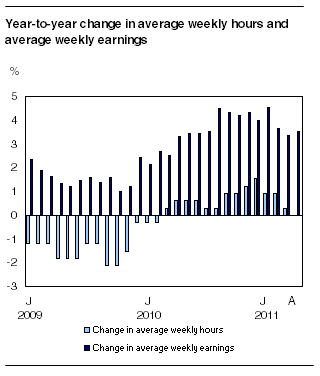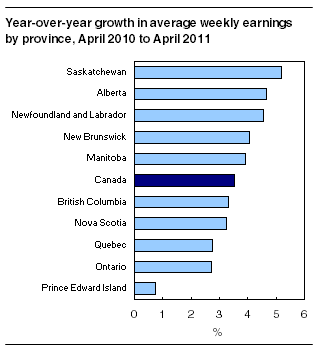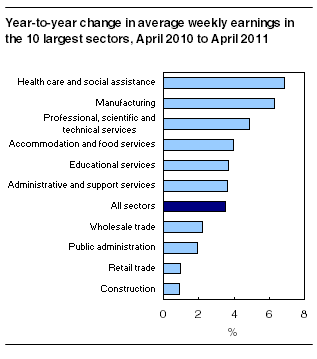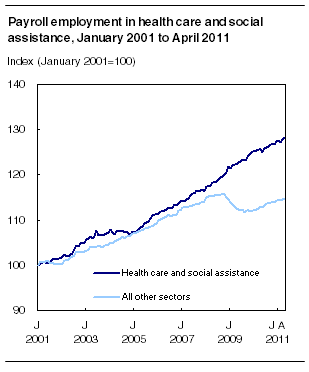Payroll employment, earnings and hours
Archived Content
Information identified as archived is provided for reference, research or recordkeeping purposes. It is not subject to the Government of Canada Web Standards and has not been altered or updated since it was archived. Please "contact us" to request a format other than those available.
Related subjects
-
[an error occurred while processing this directive]
Average weekly earnings of non-farm payroll employees increased 0.7% from March to $876.44 in April. Compared with April 2010, average weekly earnings were 3.5% higher.

The 3.5% growth in average weekly earnings during the 12 months to April was attributable to a number of factors in addition to wage growth, such as changes in the composition of employment by industry, by occupation and by level of job experience.
The average number of hours worked per week, which can also contribute to growth in average weekly earnings, was unchanged from April 2010 at 32.9 hours.
Average weekly earnings increased in every province in the 12 months to April. Growth was well above the national average in Saskatchewan, Alberta and Newfoundland and Labrador. The slowest growth was in Prince Edward Island.
Note to readers
The Survey of Employment, Payrolls and Hours (SEPH) is a business census of non-farm payroll employees. Its key objective is to provide a monthly portrait of the level of earnings, the number of jobs and hours worked by detailed industry at the national, provincial and territorial level.
Statistics Canada also produces employment estimates from its monthly Labour Force Survey (LFS). The LFS is a household survey whose main objective is to divide the working-age population into three mutually exclusive groups: the employed (including the self-employed), unemployed and not in the labour force. This survey is the official source for the unemployment rate and collects data on the socio-demographic characteristics of all those in the labour market.
As a result of conceptual and methodological differences, estimates of changes from SEPH and LFS do differ from time to time. However, the trends in the data are quite similar.
Unless otherwise stated, this release presents seasonally adjusted data, which facilitates comparisons by removing the effects of seasonal variations.
Non-farm payroll employment data are for all hourly and salaried employees, as well as "other employees" category, which includes piece-rate and commission-only employees.
Average weekly hours data are for hourly and salaried employees only and exclude businesses which could not be classified to a North American Industrial Classification System code.
All earnings data include overtime pay and exclude businesses which could not be classified to a North American Industrial Classification System code.
Average weekly earnings are derived by dividing total weekly earnings by the number of employees.
Changes in average earnings can be influenced by a number of factors. Changes in the level of earnings, the number of payroll employees, and the number of hours worked can have an impact. Other factors could include compositional changes over time, such as changes in the proportions of full-time and part-time work; proportions of casual, senior and junior employees; the occupational distribution within and across industries; and in the distribution of employment between industries. Such effects may apply differently within different provinces and territories, and over time.

Growth in average weekly earnings was above the national average of 3.5% in 6 of the 10 largest industrial sectors, led by health care and social assistance and manufacturing. The slowest growth in earnings occurred in construction and retail trade.
In the 12 months to April, average weekly earnings increased by 6.9% to $817.54 in health care and social assistance. This sector has had one of the most consistent upward trends in earnings and payroll employment since 2001, when the comparable data series began (see the "Sector profile" section of this release).
The second fastest growth in average weekly earnings in the 12 months to April occurred in manufacturing, where earnings increased by 6.3% to $989.66. Growth in this sector was particularly notable in industries such as beverage and tobacco product manufacturing; petroleum and coal product manufacturing; fabricated metal product manufacturing; and printing and related support activities.

Year-over-year growth in average weekly earnings was also above the national average in some smaller industries such as information and culture (+7.5% to $1,104.46) and arts, entertainment and recreation (+5.2% to $583.55). Weekly earnings in information and culture have been rising since July 2010, particularly among motion picture and sound recording industries; telecommunications; and data processing, hosting and related services. In arts, entertainment and recreation, earnings have been increasing since May 2009, mainly in amusement, gambling and recreation industries.
Average weekly hours worked
Average weekly hours fell 0.3% from March to April. Compared with April 2010, the average workweek was unchanged at 32.9 hours.
Notable year-over-year increases in average weekly hours worked occurred in health care and social assistance (+3.1%), information and culture (+2.9%) as well as finance and insurance (+2.7%). At the same time, there were declines in other sectors, mainly construction (-2.2%) and transportation and warehousing (-2.2%).
In mining, quarrying and oil and gas extraction, average weekly hours fell 1.7% to 40.0 hours, but this was still the highest of all sectors.
Non-farm payroll employment by sector
In April, non-farm payroll employment increased by 29,600 from March. On a year-over-year basis, the number of non-farm employees rose by 242,800 (+1.7%).
The monthly non-farm payroll employment increase in April occurred in a number of sectors, with the largest gains in manufacturing; accommodation and food services; and health care and social assistance.
The fastest year-over-year growth (+14.9%) occurred in mining, quarrying and oil and gas extraction, where payroll employment rose by 27,200. Growth in this sector was driven by gains in support activities for mining and oil and gas extraction in Alberta.
In construction, payroll employment rose by 2.9% (+23,800), the second largest year-over-year increase. This growth was spread across most provinces and occurred mainly in heavy and civil engineering construction and specialty trade contracting.
Sector profile: Health care and social assistance
From time to time, this release profiles an industrial sector with a notable trend in earnings, hours or employment. The profile for April 2011 examines the health care and social assistance sector because of its consistent trend of faster-than-average growth in earnings and employment, a trend that has spanned many years.

More than 1.6 million employees work in health care and social assistance, making it the second largest sector after retail trade. Hospitals account for the largest share (35%) of employees in the sector, followed by ambulatory health care services (26%); this latter group includes offices of physicians, dentists and other health practitioners as well as out-patient care centres. Another 22% of the sector's employees work in nursing and residential care facilities, while 17% work in social assistance.
In contrast to most other sectors, health care and social assistance has seen its share of total payroll employment increase steadily since 2001, when the comparable data series began. Currently, the sector accounts for 11% of total employment, up one full percentage point from 2001.
This sector is one of the few that recorded growth in payroll employment during the 2008-2009 economic downturn, as its number of employees increased by 3.1% between August 2008 and August 2009. During the same period, the number of payroll employees fell 3.4% in the remaining sectors of the economy.
For most of the past decade, health care and social assistance posted year-over-year increases in average weekly earnings. In the 12 months to April 2011, earnings in this sector increased by 6.9%, well above the national average of 3.5%.
Average weekly earnings of $817.54 in the sector were below the national average of $876.44. However, across the health care and social assistance industry groups, average weekly earnings ranged from $612.97 for those working in social assistance to $992.03 for those working in hospitals.
In the 12 months to April, average weekly earnings increased 9.1% to $677.34 in nursing and residential care facilities and advanced 8.2% to $835.00 in ambulatory health care services. Both gains exceeded the sector average.
Part of the 12-month growth in weekly earnings in health care and social assistance was attributable to a 3.1% increase in weekly hours, which averaged 30.3 hours in April.
Average weekly hours in this sector have been on an upward trend since October 2009. Despite the increase in April, the average number of hours worked in the sector was more than two hours below the national average of 32.9.
Available on CANSIM: tables 281-0023 to 281-0039 and 281-0041 to 281-0049.
Definitions, data sources and methods: survey number 2612.
Detailed industry data, data by size of enterprise based on employment, and other labour market indicators will be available soon in the monthly publication Employment, Earnings and Hours (72-002-X, free).
Data on payroll employment, earnings and hours for May will be released on July 28.
For more information, or to order data, contact Client Services (toll-free 1-866-873-8788; 613-951-4090; labour@statcan.gc.ca). To enquire about revisions, concepts, methods or data quality of this release, contact Lahouaria Yssaad (613-951-0627), Labour Statistics Division.
- Date modified:
